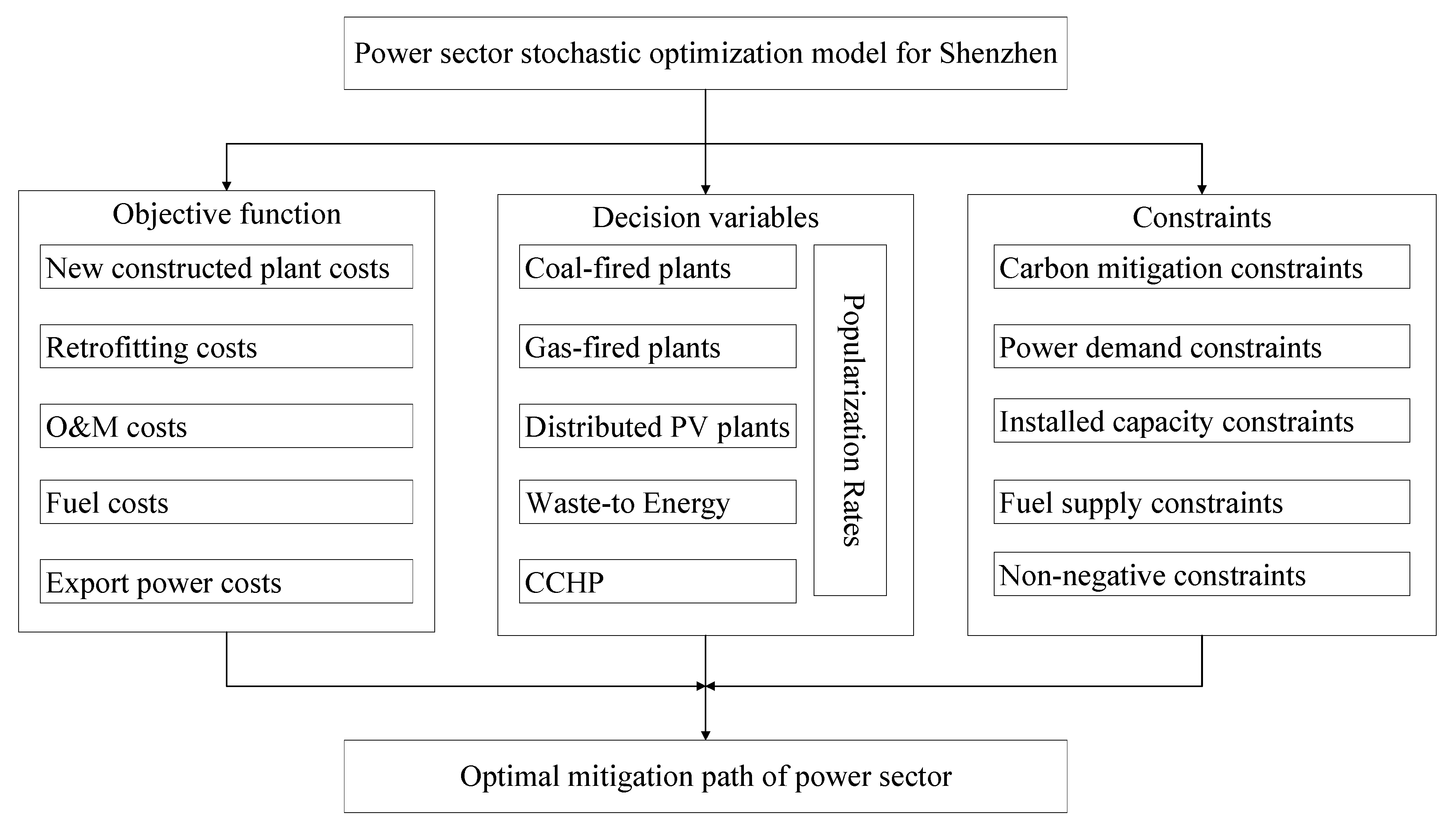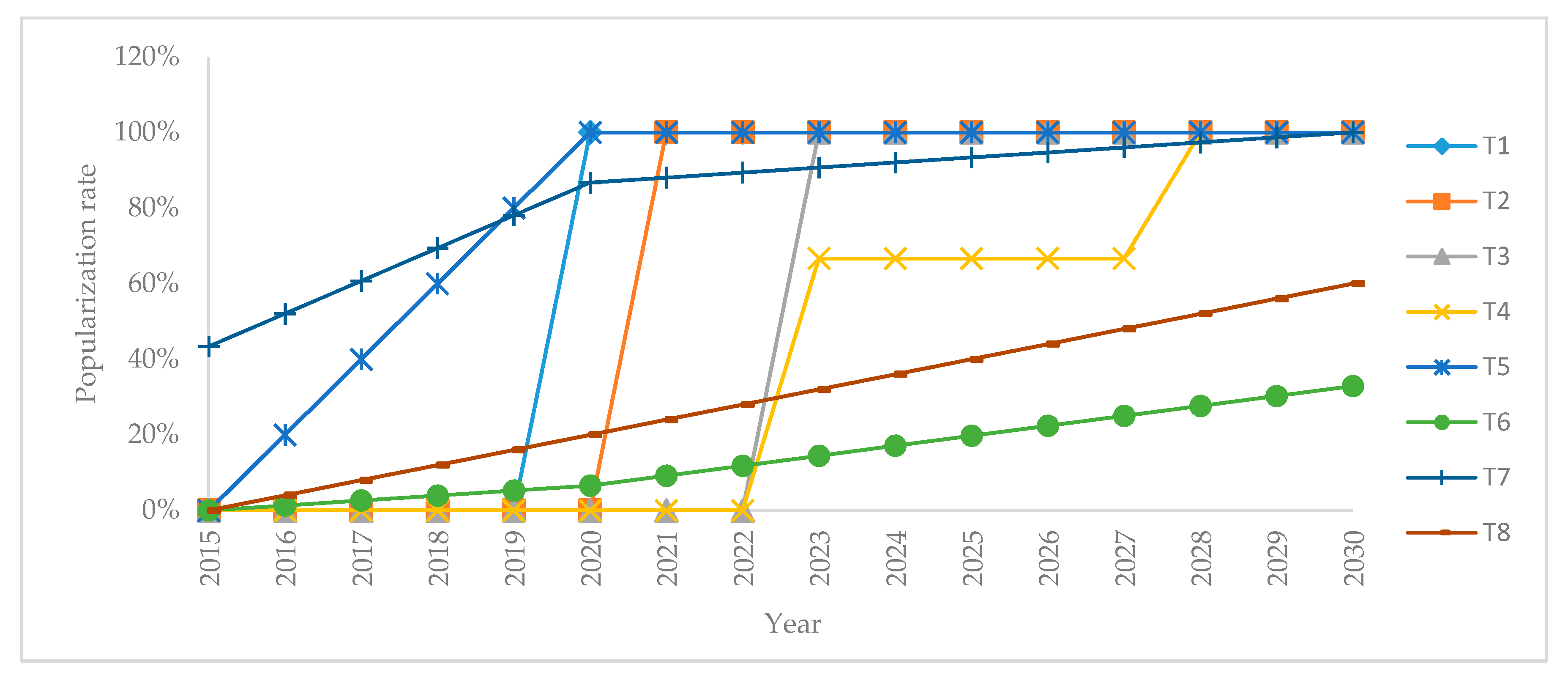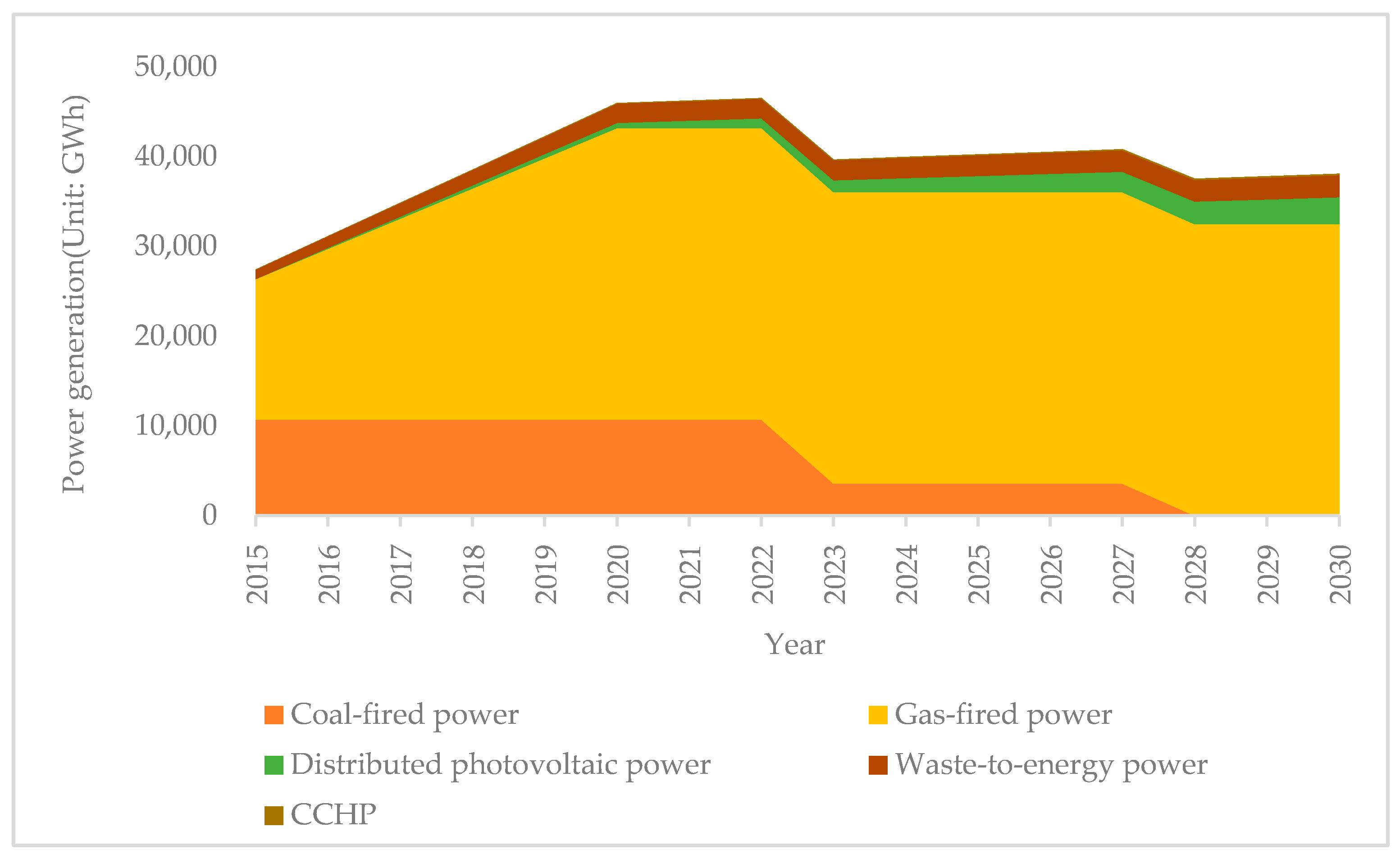A Stochastic Optimization Model for Carbon Mitigation Path under Demand Uncertainty of the Power Sector in Shenzhen, China
Abstract
:1. Introduction
2. Materials and Methods
2.1. Model Structure and Assumptions
2.2. Mathematical Formulation
- (1)
- Carbon mitigation constraints. Equation (8) means that the total amount of carbon mitigation of each technology should be greater than the planned amount of carbon emission :
- (2)
- Power demand constraints. The amount of power generated by all types of power plants each year should meet the power demand :Power demand is uncertain in the future because it is affected by many factors, such as economic growth rate and economic structure. Set the stochastic volatility of power demand is , then the power demand constraints can be expressed as:As for stochastic volatility , decision-makers need to make decisions before observing the changing value. This is called chance constrained programming, which assumes that some values in the variable are acceptable if they exceed a certain probability:where α is the confidence level that fulfills Equation (9).
- (3)
- Installed capacity constraints. Equation (10) means that the installed capacities of each type of power plant should be limited to the upper bound :
- (4)
- Fuel supply constraints. Equation (11) means that the supply of each type of fuel should be limited to the upper bound :
- (5)
- Non-negative constraints. The popularization rate of each type of technology should be set as a non-negative variable, as is shown in Equation (12). The retrofits of coal-fired and gas-fired power plants can be implemented at once, so the popularization rates of these technologies are 0 or 100% (Equation (13)):
2.3. Data Sources
3. Results and Discussion
4. Conclusions
- (1)
- The carbon mitigation technologies of existing coal-fired and gas-fired power plants will be 100% implemented in different years. Two-thirds and the remaining one-third capacity of the coal-fired power plants are going to be decommissioned in 2023 and 2028, respectively. Gas-fired power, distributed photovoltaic power, waste-to-energy power, and CCHP are going to expand their capacities gradually.
- (2)
- The installed capacity and power generation of each type of plant are changing according to their popularization rate. The installed capacity and power generation of the coal-fired power plant are decreasing, while those of other plants are increasing. The gas-fired power plants has the largest installed capacity, increasing from 69.55% to 73.78%.
- (3)
- The total costs spent in the local optimization of the Shenzhen power sector during the planning horizon are 29.29 billion yuan, and the total carbon emission is 36.20 Mt CO2. New gas-fired power has the highest costs as well as the carbon emission.
Acknowledgments
Author Contributions
Conflicts of Interest
References
- United Nations, Paris Agreement. Available online: https://unfccc.int/files/essential_background/convention/application/pdf/english_paris_agreement.pdf (accessed on 5 October 2016).
- State Grid Energy Research Institute, China Power Industry and Carbon Trading Research in 2014. Available online: http://www.doc88.com/p-6681817055456.html (accessed on 22 December 2014).
- Zhang, D.J.; Liu, P.; Ma, L.W.; Li, Z.; Ni, W.D. A multi-period modelling and optimization approach to the planning of China’s power sector with consideration of carbon dioxide mitigation. Comput. Chem. Eng. 2012, 37, 227–247. [Google Scholar] [CrossRef]
- Beér, J.M. High efficiency electric power generation: The environmental role. Prog. Energ. Combust. 2007, 33, 107–134. [Google Scholar] [CrossRef]
- Liu, T.; Xu, G.; Cai, P.; Tian, L.H.; Huang, Q.L. Development forecast of renewable energy power generation in China and its influence on the GHG control strategy of the country. Renew. Energ. 2011, 36, 1284–1292. [Google Scholar] [CrossRef]
- Jin, S.H.; Bai, L.; Kim, J.Y.; Jeong, S.J.; Kim, K.S. Analysis of GHG emission reduction in South Korea using a CO2 transportation network optimization model. Energies 2017, 10, 1027. [Google Scholar] [CrossRef]
- Yoro, K.O.; Sekoai, P.T. The potential of CO2 capture and storage technology in South Africa’s coal-fired thermal power plants. Environments 2016, 3, 24. [Google Scholar] [CrossRef]
- Mesarić, P.; Đukec, D.; Krajcar, S. Exploring the potential of energy consumers in smart grid using focus group methodology. Sustainability 2017, 9, 1463. [Google Scholar] [CrossRef]
- Siano, P. Demand response and smart grids—A survey. Renew. Sustain. Energy Rev. 2014, 30, 461–478. [Google Scholar] [CrossRef]
- Shi, J.Q.; Wang, Y.R.; Fu, R.B.; Zhang, J.H. Operating strategy for local-area energy systems integration considering uncertainty of supply-side and demand-side under conditional value-at-risk assessment. Sustainability 2017, 9, 1655. [Google Scholar] [CrossRef]
- Ye, M.H.; Cai, W.J.; Wang, C. A multi-period multi-region optimization model of China’s power sector considering synergetic CO2 and air pollutants control. Procedia Environ. Sci. 2013, 18, 397–403. [Google Scholar] [CrossRef]
- Cheng, R.; Xu, Z.F.; Liu, P.; Wang, Z.; Li, Z.; Jones, I. A multi-region optimization planning model for China’s power sector. Appl. Energy 2015, 137, 413–426. [Google Scholar] [CrossRef]
- Chen, H.; Tang, B.J.; Liao, H.; Wei, Y.M. A multi-period power generation planning model incorporating the non-carbon external costs: A case study of China. Appl. Energ. 2016, 183, 1333–1345. [Google Scholar] [CrossRef]
- Lee, J.Y. A multi-period optimization model for planning carbon sequestration retrofits in the electricity sector. Appl. Energy 2017, 198, 12–20. [Google Scholar] [CrossRef]
- Rong, A.; Lahdelma, R. CO2 emissions trading planning in combined heat and power production via multi-period stochastic optimization. Eur. J. Oper. Res. 2007, 176, 1874–1895. [Google Scholar] [CrossRef]
- Li, M.W.; Li, Y.P.; Huang, G.H. An interval-fuzzy two-stage stochastic programming model for planning carbon dioxide trading under uncertainty. Energy 2011, 36, 5677–5689. [Google Scholar] [CrossRef]
- Cai, Y.P.; Huang, G.H.; Yang, Z.F.; Tan, Q. Identification of optimal strategies for energy management systems planning under multiple uncertainties. Appl. Energy 2009, 86, 480–495. [Google Scholar] [CrossRef]
- Lin, Q.G.; Huang, G.H. Planning of energy system management and GHG-emission control in the municipality of Beijing—An inexact-dynamic stochastic programming model. Energy Policy 2009, 37, 4463–4473. [Google Scholar] [CrossRef]
- Pei, L.; Pistikopoulos, E.N.; Zheng, L. Decomposition based stochastic programming approach for polygeneration energy systems design under uncertainty. Ind. Eng. Chem. Res. 2010, 49, 3295–3305. [Google Scholar] [CrossRef]
- Chen, W.T.; Li, Y.P.; Huang, G.H.; Chen, X.; Li, Y.F. A two-stage inexact-stochastic programming model for planning carbon dioxide emission trading under uncertainty. Appl. Energy 2010, 87, 1033–1047. [Google Scholar] [CrossRef]
- Xie, Y.L.; Li, Y.P.; Huang, G.H.; Li, Y.F. An interval fixed-mix stochastic programming method for greenhouse gas mitigation in energy systems under uncertainty. Energy 2010, 35, 4627–4644. [Google Scholar] [CrossRef]
- Li, Y.P.; Huang, G.H.; Chen, X. Planning regional energy system in association with greenhouse gas mitigation under uncertainty. Appl. Energy 2011, 88, 599–611. [Google Scholar] [CrossRef]
- Khayyam, H.; Naebe, M.; Bab-Hadiashar, A.; Jamshidi, F.; Li, Q.; Atkiss, S.; Buckmaster, D.; Fox, B. Stochastic optimization models for energy management in carbonization process of carbon fiber production. Appl. Energy 2015, 158, 643–655. [Google Scholar] [CrossRef]
- Han, J.H.; Lee, I.B. Two-stage stochastic programming model for planning CO2 utilization and disposal infrastructure considering the uncertainty in the CO2 emission. Ind. Eng. Chem. Res. 2011, 50, 13435–13443. [Google Scholar] [CrossRef]
- Han, J.H.; Lee, I.B. Multiperiod stochastic optimization model for carbon capture and storage infrastructure under uncertainty in CO2 emissions, product prices, and operating costs. Ind. Eng. Chem. Res. 2012, 51, 11445–11457. [Google Scholar] [CrossRef]
- Hu, M.Q.; Cho, H.J. A probability constrained multi-objective optimization model for CCHP system operation decision support. Appl. Energy 2014, 116, 230–242. [Google Scholar] [CrossRef]
- Spangardt, G.; Lucht, M.; Handschin, E. Applications for stochastic optimization in the power industry. Electr. Eng. 2006, 88, 177–182. [Google Scholar] [CrossRef]
- Zhang, D.J.; Liu, P.; Ma, L.W.; Li, Z. A multi-period optimization model for optimal planning of China’s power sector with consideration of carbon mitigation—The optimal pathway under uncertain parametric conditions. Comput. Chem. Eng. 2013, 50, 196–206. [Google Scholar] [CrossRef]
- Koltsaklis, N.E.; Liu, P.; Georgiadis, M.C. An integrated stochastic multi-regional long-term energy planning model incorporating autonomous power systems and demand response. Energy 2015, 82, 865–888. [Google Scholar] [CrossRef]
- Shenzhen Government Online, Shenzhen Statistical Yearbook 2016. Available online: http://www.sz.gov.cn/cn/xxgk/zfxxgj/tjsj/tjnj/201701/W020170120506125327799.pdf (accessed on 20 January 2017).
- National Development and Reform Commission, China-US Joint Presidential Statement on Climate Change. Available online: http://www.ndrc.gov.cn/gzdt/201509/W020150922344556917878.pdf (accessed on 16 September 2015).
- Selosse, S.; Ricci, O. Carbon capture and storage: Lessons from a storage potential and localization analysis. Appl. Energy 2017, 188, 32–44. [Google Scholar] [CrossRef]
- National Development and Reform Commission, Promotional Catalogues of National Key Energy-Saving and Low-Carbon Technologies (2016, Energy-Saving). Available online: http://www.ndrc.gov.cn/gzdt/201701/t20170119_835583.html (accessed on 30 December 2016).
- Ministry of Environmental Protection of the People’s Republic of China. Guiding Catalogues of National Key Industries’ Cleaner Production Technology. Available online: http://www.mep.gov.cn/gkml/hbb/gwy/200910/t20091030_180702.htm (accessed on 27 February 2003).
- National Development and Reform Commission. The 13th Five-Year Energy Plan. Available online: http://www.ndrc.gov.cn/zcfb/zcfbtz/201701/W020170117335278192779.pdf (accessed on 26 December 2016).
- National Development and Reform Commission. The 13th Five-Year Renewable Energy Plan. Available online: http://www.ndrc.gov.cn/zcfb/zcfbtz/201612/W020161216659579206185.pdf (accessed on 10 December 2016).
- Development and Reform Commission of Shnzhen Municipality. Long-Term Planning of Low Carbon Development in Shenzhen (2011–2020). Available online: http://www.szpb.gov.cn/wx/wx_dtxx/fgzl_wx/zxgh/201310/t20131016_2223234.htm (accessed on 16 October 2013).




| Plant Types | Symbol | Carbon Mitigation Types |
|---|---|---|
| Coal-fired power | i1 | Boiler intelligent blowing optimization |
| i2 | Gas ignition system | |
| i3 | Retrofitting of boiler air preheater | |
| i4 | Steam seal modification for steam turbine | |
| i5 | Condenser energy saving system | |
| i6 | Retrofit of steam turbine flow passage | |
| i7 | Generation capacity enlargement | |
| i8 | High voltage variable frequency speed | |
| i9 | High-efficiency motor replacement | |
| i10 | Coal-fired power decommissions early | |
| Gas-fired power | i11 | Increasing the heating surface of the boiler |
| i12 | Retrofitting of condensing steam turbine | |
| i13 | Waste heat utilization of gas turbine rotor | |
| i14 | inlet air cooling of gas turbine | |
| i15 | New Gas-fired power | |
| Solar power | i16 | Distributed photovoltaic power |
| Waste-to-energy | i17 | Waste-to-energy power |
| CCHP | i18 | CCHP |
| Symbol | Physical Meaning |
|---|---|
| k | Power plant type () |
| t | Year |
| i | Carbon mitigation technology type () |
| f | Fuel type |
| The popularization of carbon mitigation technology i (%) | |
| The popularization of carbon mitigation technology implemented in power plant k (%) | |
| I | Discount rate (%) |
| Stochastic volatility | |
| Total capital costs of newly constructed power plants in year t | |
| Total capital costs of newly constructed power plant k in year t | |
| Total capital costs for implement carbon mitigation technologies in year t | |
| Total capital costs of power plant k for implement carbon mitigation technology i in year t | |
| Total operation and maintenance costs in year t | |
| Total operation and maintenance coat of power plant k in year t | |
| Costs of fuel f in year t | |
| Costs of fuel f in year t | |
| Price of fuel f in year t | |
| Demand for fuel f of power plant k in year t | |
| Total costs of export power in year t | |
| Installed capacity that can implement technology i in year t | |
| The annual saved amount of fuel j after implementing technology i | |
| Carbon emission factor of fuel f | |
| The planned amount of carbon mitigation in year t | |
| The installed capacity of power plant k in year t | |
| Annual operational hours of power plant k | |
| The maximum installed capacities of newly constructed power plant k in year t | |
| The maximum installed capacities of newly constructed power plant k | |
| Power demand in power sector in year t | |
| Export power supply | |
| The upper limit of installed capacity of power plant k | |
| The upper limit of fuel f supply in year t | |
| The probability of event A |
| Technology | Total Costs (Billion Yuan) | Proportion | Total Carbon Emission (Mt CO2) | Proportion |
|---|---|---|---|---|
| i1 | −0.0031 | −0.01% | −0.0277 | −0.08% |
| i2 | 0.0272 | 0.09% | 0.0228 | 0.06% |
| i3 | 0.0010 | 0.00% | −0.0177 | −0.05% |
| i4 | −0.0005 | 0.00% | −0.0055 | −0.02% |
| i5 | −0.0096 | −0.03% | −0.0998 | −0.28% |
| i6 | −0.0128 | −0.04% | −0.1802 | −0.50% |
| i7 | −0.0005 | 0.00% | −0.0166 | −0.05% |
| i8 | −0.0001 | 0.00% | −0.0026 | −0.01% |
| i9 | 0.0008 | 0.00% | −0.0063 | −0.02% |
| i10 | 0.7902 | 2.70% | 10.1535 | 28.05% |
| i11 | −0.0310 | −0.11% | −0.0529 | −0.15% |
| i12 | −0.1851 | −0.63% | −0.2881 | −0.80% |
| i13 | −0.0179 | −0.06% | −0.0309 | −0.09% |
| i14 | −0.0027 | −0.01% | −0.0158 | −0.04% |
| i15 | 18.6721 | 63.76% | 23.2824 | 64.31% |
| i16 | 8.2442 | 28.15% | 1.2516 | 3.46% |
| i17 | 1.6674 | 5.69% | 2.1611 | 5.97% |
| i18 | 0.1468 | 0.50% | 0.0770 | 0.21% |
| Total | 29.2866 | 100.00% | 36.2042 | 100.00% |
© 2017 by the authors. Licensee MDPI, Basel, Switzerland. This article is an open access article distributed under the terms and conditions of the Creative Commons Attribution (CC BY) license (http://creativecommons.org/licenses/by/4.0/).
Share and Cite
Hu, G.; Ma, X.; Ji, J. A Stochastic Optimization Model for Carbon Mitigation Path under Demand Uncertainty of the Power Sector in Shenzhen, China. Sustainability 2017, 9, 1942. https://doi.org/10.3390/su9111942
Hu G, Ma X, Ji J. A Stochastic Optimization Model for Carbon Mitigation Path under Demand Uncertainty of the Power Sector in Shenzhen, China. Sustainability. 2017; 9(11):1942. https://doi.org/10.3390/su9111942
Chicago/Turabian StyleHu, Guangxiao, Xiaoming Ma, and Junping Ji. 2017. "A Stochastic Optimization Model for Carbon Mitigation Path under Demand Uncertainty of the Power Sector in Shenzhen, China" Sustainability 9, no. 11: 1942. https://doi.org/10.3390/su9111942





